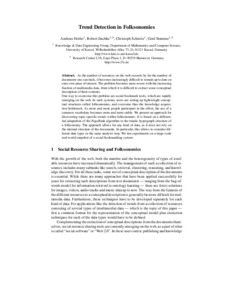Datum
2006Schlagwort
004 Informatik World Wide WebWissenserwerbWissensmanagementOntologie <Wissensverarbeitung>Metadata
Zur Langanzeige
Preprint

Trend detection in folksonomies
Zusammenfassung
As the number of resources on the web exceeds by far the number of documents one can track, it becomes increasingly difficult to remain up to date on ones own areas of interest. The problem becomes more severe with the increasing fraction of multimedia data, from which it is difficult to extract some conceptual description of their contents. One way to overcome this problem are social bookmark tools, which are rapidly emerging on the web. In such systems, users are setting up lightweight conceptual structures called folksonomies, and overcome thus the knowledge acquisition bottleneck. As more and more people participate in the effort, the use of a common vocabulary becomes more and more stable. We present an approach for discovering topic-specific trends within folksonomies. It is based on a differential adaptation of the PageRank algorithm to the triadic hypergraph structure of a folksonomy. The approach allows for any kind of data, as it does not rely on the internal structure of the documents. In particular, this allows to consider different data types in the same analysis step. We run experiments on a large-scale real-world snapshot of a social bookmarking system.
Zitieren
@article{urn:nbn:de:hebis:34-2009042027008,
author={Hotho, Andreas and Jäschke, Robert and Schmitz, Christoph and Stumme, Gerd},
title={Trend detection in folksonomies},
year={2006}
}
0500 Oax
0501 Text $btxt$2rdacontent
0502 Computermedien $bc$2rdacarrier
1100 2006$n2006
1500 1/eng
2050 ##0##urn:nbn:de:hebis:34-2009042027008
3000 Hotho, Andreas
3010 Jäschke, Robert
3010 Schmitz, Christoph
3010 Stumme, Gerd
4000 Trend detection in folksonomies / Hotho, Andreas
4030
4060 Online-Ressource
4085 ##0##=u http://nbn-resolving.de/urn:nbn:de:hebis:34-2009042027008=x R
4204 \$dPreprint
4170
5550 {{World Wide Web}}
5550 {{Wissenserwerb}}
5550 {{Wissensmanagement}}
5550 {{Ontologie <Wissensverarbeitung>}}
7136 ##0##urn:nbn:de:hebis:34-2009042027008
<resource xsi:schemaLocation="http://datacite.org/schema/kernel-2.2 http://schema.datacite.org/meta/kernel-2.2/metadata.xsd"> 2009-04-20T09:20:00Z 2009-04-20T09:20:00Z 2006 urn:nbn:de:hebis:34-2009042027008 http://hdl.handle.net/123456789/2009042027008 246148 bytes application/pdf eng Urheberrechtlich geschützt https://rightsstatements.org/page/InC/1.0/ 004 Trend detection in folksonomies Preprint As the number of resources on the web exceeds by far the number of documents one can track, it becomes increasingly difficult to remain up to date on ones own areas of interest. The problem becomes more severe with the increasing fraction of multimedia data, from which it is difficult to extract some conceptual description of their contents. One way to overcome this problem are social bookmark tools, which are rapidly emerging on the web. In such systems, users are setting up lightweight conceptual structures called folksonomies, and overcome thus the knowledge acquisition bottleneck. As more and more people participate in the effort, the use of a common vocabulary becomes more and more stable. We present an approach for discovering topic-specific trends within folksonomies. It is based on a differential adaptation of the PageRank algorithm to the triadic hypergraph structure of a folksonomy. The approach allows for any kind of data, as it does not rely on the internal structure of the documents. In particular, this allows to consider different data types in the same analysis step. We run experiments on a large-scale real-world snapshot of a social bookmarking system. open access Hotho, Andreas Jäschke, Robert Schmitz, Christoph Stumme, Gerd Auch erschienen in: Avrithis, Yannis u.a. (Hrsg.): Semantic multimedia. (Lecture notes in computer science ; 4306). Berlin u.a. : Springer, 2006. S. 56-70. ISBN 3-540-49335-2 = 978-3-540-49335-8 (The original publication is available at www.springerlink.com) World Wide Web Wissenserwerb Wissensmanagement Ontologie <Wissensverarbeitung> </resource>
Die folgenden Lizenzbestimmungen sind mit dieser Ressource verbunden:
Urheberrechtlich geschützt

